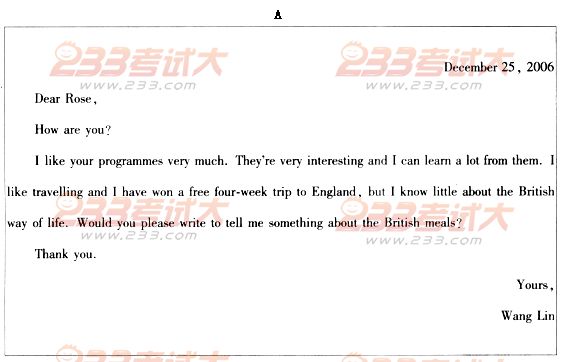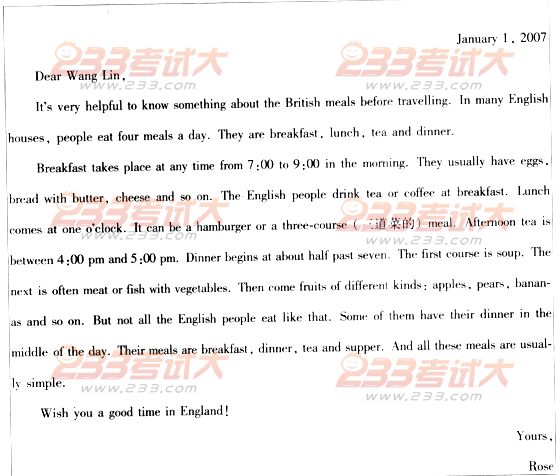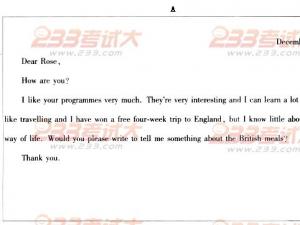Ⅲ.阅读理解/Reading comprehension(50分)


36. Wang Lin wrote to _________.
A. say hello to Rose
B. ask Rose about the British meals
C. tell Rose about the free trip
D. tell Rose that he liked her programmes
37. The possible time for breakfast in England is _________.
A. from 7:00 pm to 9:00 pm
B. from 7:00 am to 9:00 am
C. from 4:00 pm to 5:00 pm
D. from 4:00 am to 5:00 am
38. In England, afternoon tea often takes place _________.
A. before lunch
B. between breakfast and lunch
C. during supper
D. between lunch and dinner
39. The second course at dinner is often _________ at British meals.
A. soup
B. cheese
C. bread with butter
D. meat or fish with vegetables
40. Rose answered the letter _________.
A. on New Year's Day
B. at the Lantern Festival
C. on New Year's Eve
D. on Christmas Day
B
The largest earthquake (magnitude 里氏 9.5 ) of the 20th century happened on May 22, 1960 off the coast of South Central Chile.
It generated (生成) one of the most destructive Pacific-wide tsunamis (海啸 ). Near the generating area, both the earthquake and the tsunami were very much destructive, particularly in the coastal area from Concepcion to the south end of Isla Chiloe. The largest tsunami damage occurred at Isla Chiloe--the coastal area closest to the epicenter(震中). Huge tsunami waves measuring as high as 25 meters arrived within 10 to 15 minutes after the earthquake, killing at least two hundred people, sinking all the boats, and flooding half a kilometer inland.
There was large damage and loss of life at Concepcion, Chile' s top industrial city. Near the city of Valdivia, the earthquake and following aftershocks generated landslides which killed 18 people. At the port city of Valparaiso, a city of 200,000, many buildings collapsed. A total of 130,000 houses were destroyed--one in every three in the earthquake zone and nearly 2,000,000 people were left homeless.
Total damage losses, including to agriculture and to industry, were estimated (估计) to be over a half billion dollars. The total number of deaths related with both the tsunami and the earthquake was never found accurately for the region. Estimates of deaths reached between 490 to 5,7002 with no distinction(差别) as to how many deaths were caused by the earthquake and how many were caused by the tsunami. However, it is believed that most of the deaths in Chile were caused by the tsunami.
41. Where did the largest tsunami damage occur?
A. Concepcion.
B. Isla Chiloe.
C. Valdivia.
D. Valparaiso.
42. What can we learn about the tsunami waves generated by the earthquake?
A. The tsunami waves as high as 25 meters arrived immediately after the earthquake.
B. The tsunami waves killed 200 people and sank all the boats.
C. The tsunami waves were very destructive.
D. The tsunami waves flooded half of the inland.
43. What is generally thought the main cause of deaths in Chile?
A. Landslides.
B. The tsunami.
C. Aftershocks.
D. The magnitude 9.5 earthquake.
44. What is the total number of deaths in the earthquake?
A. 2,000,000.
B. Between 490 to 5, 7002.
C. 200,000.
D. It was hard to know.
45. What does the underlined word "collapsed" probably mean?
A. Were destroyed.
B. Caught fire.
C. Were flooded.
D. Sank.
C
Some futurologists have assumed that the vast upsurge (剧增) of women in the workforce may portend a rejection of marriage. Many women, according to this hypothesis, would rather work than marry. The converse (反面)of this concern is that the prospects of becoming a multi-paycheck household could encourage marriage. In the past, only the earnings and financial prospects of the man counted in the marriage decision. Now, however, the earning ability of a woman can make her more attractive as a marriage partner. Data show that economic downturns tend to put off marriage because the parties cannot afford to establish a family or are concerned about rainy days ahead. As the economy comes to life, the number of marriages also rises.
The increase in divorce rates follows, with the increase in women working outside the home. Yet, it may be wrong to jump to any simple cause-and-effect conclusions. The impact of a wife' s work on divorce is no less cloudy than its impact on marriage decisions. The realization that she can be a good provider may increase the chances that a working wife will choose divorce over an unsatisfactory marriage. But the reverse is equally plausible(似是而非的). Tensions grounded in financial problems often play a key role in ending a marriage. By raising a family' s standard of living, a working wife may strengthen her family' s financial and emotional stability.
Psychological factors also should be considered. For example, a wife blocked from a career outside the home may feel caged in the house. She may view her only choice as seeking a divorce. On the other hand, if she can find fulfillment through work outside the home, work and marriage can go together to create a stronger and more stable union.
Also, a major part of women' s inequality in marriage has been due to the fact that, in most cases, men have remained the main breadwinners. A working wife may rob a husband of being the master of the house. Depending upon how the couple reacts to these new conditions, it could create a stronger equal partnership or it could create new insecurities.
46. The word "portend
